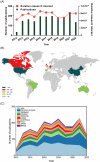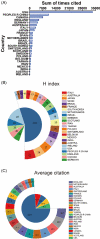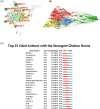The research landscape of immunology research in spinal cord injury from 2012 to 2022
- PMID: 37780822
- PMCID: PMC10540832
- DOI: 10.1002/jsp2.1261
The research landscape of immunology research in spinal cord injury from 2012 to 2022
Abstract
Background: Spinal cord injury (SCI) is defined as traumatic damage to the spinal cord, affecting over three million patients worldwide, and there is still no treatment for the injured spinal cord itself. In recent years, immunology research on SCI has been published in various journals.
Methods: To systematically analyze the research hotspots and dynamic scientific developments of immunology research in SCI, we conducted a bibliometric and knowledge map analysis to help researchers gain a global perspective in this research field.
Results: The bibliometric study we completed included 1788 English-language papers published in 553 journals by 8861 authors from 1901 institutions in 66 countries/regions. Based on the references and keyword analysis, researchers in the past 10 years have mainly focused on the research directions of "monocyte chemoattractor protein 1," "nitric oxide," "pain," and "nitric oxide synthase" related to immunological research in SCI. However, with the development of other new directions such as "extracellular vesicles" (2019-2022), "Regenerative medicine" (2019-2022), "stromal cells" (2018-2022), "motor recovery" (2019-2022), and "glial activation" (2019-2022). Researchers prefer to study the application of regenerative strategies in SCI, the mechanism of extracellular vesicles in the development of SCI, the activation of spinal glial cells in SCI, and the pathways of motor recovery. This bibliometric analysis of immunology research in SCI summarizes the current status of this research field. The relationship between extracellular vesicles, regenerative medicine, stromal cells, motor recovery, and glial activation is currently a major research frontier. Further research and cooperation worldwide need to be enhanced.
Conclusion: We believe that our research can help researchers quickly grasp the current hotspot of immunology research in SCI and determine a new direction for future research.
Keywords: CiteSpace; VOSviewer; bibliometric analysis; immunology; spinal cord injury.
© 2023 The Authors. JOR Spine published by Wiley Periodicals LLC on behalf of Orthopaedic Research Society.
Conflict of interest statement
The authors declare no conflicts of interest.
Figures









Similar articles
-
Research hotspots and trends of microRNAs in spinal cord injury: a comprehensive bibliometric analysis.Front Neurol. 2024 May 21;15:1406977. doi: 10.3389/fneur.2024.1406977. eCollection 2024. Front Neurol. 2024. PMID: 38836004 Free PMC article.
-
Research hotspots and trend analysis of cell transplantation in traumatic spinal cord injury: a bibliometric and visualized analysis.Front Pharmacol. 2023 Dec 11;14:1326583. doi: 10.3389/fphar.2023.1326583. eCollection 2023. Front Pharmacol. 2023. PMID: 38161703 Free PMC article.
-
Emerging trends and hot spots in autoimmune thyroiditis research from 2000 to 2022: A bibliometric analysis.Front Immunol. 2022 Aug 11;13:953465. doi: 10.3389/fimmu.2022.953465. eCollection 2022. Front Immunol. 2022. PMID: 36032148 Free PMC article.
-
Research progress in neuropathic pain after spinal cord injury: a bibliometric study from 2013 to 2024.Front Neurol. 2024 Dec 24;15:1486584. doi: 10.3389/fneur.2024.1486584. eCollection 2024. Front Neurol. 2024. PMID: 39777308 Free PMC article.
-
Immunoregulation of Glia after spinal cord injury: a bibliometric analysis.Front Immunol. 2024 Jun 13;15:1402349. doi: 10.3389/fimmu.2024.1402349. eCollection 2024. Front Immunol. 2024. PMID: 38938572 Free PMC article.
Cited by
-
Decoding trends in mRNA vaccine research: A comprehensive bibliometric study.Hum Vaccin Immunother. 2024 Dec 31;20(1):2355037. doi: 10.1080/21645515.2024.2355037. Epub 2024 May 30. Hum Vaccin Immunother. 2024. PMID: 38813652 Free PMC article.
-
NeuroAiDTM-II (MLC901) Promoted Neurogenesis by Activating the PI3K/AKT/GSK-3β Signaling Pathway in Rat Spinal Cord Injury Models.Biomedicines. 2024 Aug 21;12(8):1920. doi: 10.3390/biomedicines12081920. Biomedicines. 2024. PMID: 39200383 Free PMC article.
References
-
- Cox CS. Cellular therapy for traumatic neurological injury. Pediatr Res. 2018;83(1):325‐332. - PubMed
-
- Ahuja CS, Nori S, Tetreault L, et al. Traumatic spinal cord injury—repair and regeneration. Neurosurgery. 2017;80(3S):S9‐S22. - PubMed
-
- Ahuja CS, Wilson JR, Nori S, et al. Traumatic spinal cord injury. Nat Rev Dis Primers. 2017;3(1):1‐21. - PubMed
-
- Norenberg MD, Smith J, Marcillo A. The pathology of human spinal cord injury: defining the problems. J Neurotrauma. 2004;21(4):429‐440. - PubMed
-
- Fleming JC, Norenberg MD, Ramsay DA, et al. The cellular inflammatory response in human spinal cords after injury. Brain. 2006;129(12):3249‐3269. - PubMed
LinkOut - more resources
Full Text Sources
Research Materials
Miscellaneous

